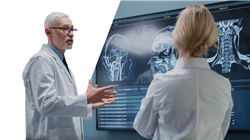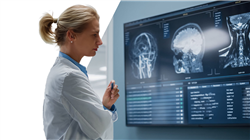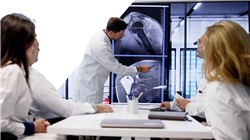University certificate
The world's largest artificial intelligence faculty”
Why study at TECH?
Thanks to this Relearning-based Postgraduate diploma, you will create Artificial Intelligence models that enable the early identification of diseases from the analysis of Medical Images”

The field of Medicine faces the challenge of handling and analyzing an increasing volume of data from various imaging modalities such as MRI, CT and ultrasound scans. Faced with this situation, Artificial Intelligence and Big Data technologies emerge as key tools to address these challenges, offering advanced solutions for the processing and analysis of Medical Images.
For this reason, specialists need to handle these tools to optimize the interpretation of complex images, facilitating accurate disease detection and informed clinical decision making.
In this context, TECH is developing an innovative program in Artificial Intelligence and Big Data Technologies for Medical Image Processing. The academic itinerary will delve into factors ranging from the analysis of large image datasets to the training of Machine Learning algorithms. Along the same lines, the didactic materials will address in detail the legal and ethical aspects related to the use of Artificial Intelligence in Diagnostic Imaging.
Therefore, graduates will acquire advanced skills to implement solutions based on Artificial Intelligence to increase the accuracy of clinical diagnoses.
For the mastery of all the contents of this itinerary, doctors have a disruptive methodology: Relearning. This TECH-driven system promotes the gradual assimilation of the most complex concepts through repetition. Also, the program is developed 100% online, another significant advantage that provides autonomy to the graduates, allowing them to organize their learning pace depending on their other obligations. Besides, the university program is supported by a variety of complementary materials such as updated scientific articles and infographics. All of this is accompanied by explanatory videos, interactive summaries and self-assessment tests that enhance the comprehensive specialization of specialists, making this academic option a truly unparalleled opportunity.
You will learn valuable lessons through real cases in simulated learning environments"
This Postgraduate diploma in Artificial Intelligence and Big Data Technologies for Medical Imaging Processing contains the most complete and up-to-date program on the market. The most important features include:
- Development of practical cases presented by experts in Artificial Intelligence
- The graphic, schematic and eminently practical contents with which it is conceived gather scientific and practical information on those disciplines that are indispensable for professional practice
- Practical exercises where self-assessment can be used to improve learning
- Its special emphasis on innovative methodologies
- Theoretical lessons, questions to the expert, debate forums on controversial topics, and individual reflection assignments
- Content that is accessible from any fixed or portable device with an Internet connection
You will use Artificial Intelligence to identify subtle patterns in Images to enable early detection of Neurodegenerative Diseases”
The program’s teaching staff includes professionals from the field who contribute their work experience to this educational program, as well as renowned specialists from leading societies and prestigious universities.
The multimedia content, developed with the latest educational technology, will provide the professional with situated and contextual learning, i.e., a simulated environment that will provide immersive education programmed to learn in real situations.
This program is designed around Problem-Based Learning, whereby the professional must try to solve the different professional practice situations that arise during the course. For this purpose, students will be assisted by an innovative interactive video system created by renowned and experienced experts.
Are you looking to implement classification and detection techniques to categorize different pathologies in Medical Imaging? Achieve it through this program in only 6 months"

Study at your own pace, with the convenience offered by TECH's online mode"
Syllabus
This program has been put together by true experts in Artificial Intelligence and Big Data Technologies for Medical Imaging Processing. The study plan will delve into issues ranging from the analysis of large volumes of image data or Machine Learning algorithms to the application of Machine Learning to analyze epidemic outbreaks. In addition, the agenda will delve into the legal and ethical considerationsrelated to the use of Artificial Intelligence applied to Diagnostic Imaging. Therefore, graduates will develop advanced skills to implement Artificial Intelligence solutions to improve the accuracy of medical diagnoses.

You will implement the most innovative algorithms to improve diagnostic accuracy and efficiency in Medical Image Processing”
Module 1. Artificial Intelligence Innovations in Diagnostic Imaging
1.1. Artificial Intelligence Technologies and Tools in Diagnostic Imaging with IBM Watson Imaging Clinical Review
1.1.1. Leading Software Platforms for Medical Image Analysis
1.1.2. Radiology-Specific Deep Learning Tools
1.1.3. Innovations in Hardware to Accelerate Image Processing
1.1.4. Integration of Artificial Intelligence Systems in Existing Hospital Infrastructures
1.2. Statistical Methods and Algorithms for Medical Image Interpretation with DeepMind AI for Breast Cancer Analysis
1.2.1. Image Segmentation Algorithms
1.2.2. Classification and Detection Techniques in Medical Images
1.2.3. Use of Convolutional Neural Networks in Radiology
1.2.4. Noise Reduction and Image Quality Improvement Methods
1.3. Design of Experiments and Analysis of Results in Diagnostic Imaging with Google Cloud Healthcare API
1.3.1. Design of Validation Protocols for Artificial Intelligence Algorithms
1.3.2. Statistical Methods for Comparing the Performance of Artificial Intelligence and Radiologists
1.3.3. Setting Up Multicenter Studies for Artificial Intelligence Testing
1.3.4. Interpretation and Presentation of Performance Test Results
1.4. Detection of Subtle Patterns in Low-Resolution Images
1.4.1. Artificial Intelligence for Early Diagnosis of Neurodegenerative Diseases
1.4.2. Artificial Intelligence Applications in Interventional Cardiology
1.4.3. Use of Artificial Intelligence for the Optimization of Imaging Protocols
1.5. Biomedical Image Analysis and Processing
1.5.1. Pre-Processing Techniques to Improve Automatic Interpretation
1.5.2. Texture and Pattern Analysis in Histological Images
1.5.3. Extraction of Clinical Features from Ultrasound Images
1.5.4. Methods for Longitudinal Analysis of Images in Clinical Studies
1.6. Advanced Data Visualization in Diagnostic Imaging with OsiriX MD
1.6.1. Development of Graphical Interfaces for 3D Image Exploration
1.6.2. Tools for Visualization of Temporal Changes in Medical Images
1.6.3. Augmented Reality Techniques for the Teaching of Anatomy
1.6.4. Real-Time Visualization Systems for Surgical Procedures
1.7. Natural Language Processing in Medical Image Documentation and Reporting with Nuance PowerScribe 360
1.7.1. Automatic Generation of Radiological Reports
1.7.2. Extraction of Relevant Information from Electronic Medical Records
1.7.3. Semantic Analysis for the Correlation of Imaging and Clinical Findings
1.7.4. Image Search and Retrieval Tools Based on Textual Descriptions
1.8. Integration and Processing of Heterogeneous Data in Medical Imaging
1.8.1. Fusion of Imaging Modalities for Complete Diagnostics
1.8.2. Integration of Laboratory and Genetic Data in the Image Analysis
1.8.3. Systems for Handling Large Volumes of Imaging Data
1.8.4. Strategies for Normalization of Datasets from Multiple Sources
1.9. Applications of Neural Networks in Medical Image Interpretation with Zebra Medical Vision
1.9.1. Use of Generative Networks for the Creation of Synthetic Medical Images
1.9.2. Neural Networks for Automatic Tumor Classification
1.9.3. Deep Learning for the Analysis of Time Series in Functional Imaging
1.9.4. Fitting of Pre-Trained Models on Specific Medical Image Datasets
1.10. Predictive Modeling and its Impact on Diagnostic Imaging with IBM Watson Oncology
1.10.1. Predictive Models for Risk Assessment in Oncology Patients
1.10.2. Predictive Tools for Chronic Disease Follow-Up
1.10.3. Survival Analysis Using Medical Imaging Data
1.10.4. Prediction of Disease Progression using Machine Learning Techniques
Module 2. Big Data and Predictive Analytics in Medical Imaging
2.1. Big Data in Diagnostic Imaging: Concepts and Tools with GE Healthcare Edison
2.1.1. Fundamentals of Big Data applied to Imaging
2.1.2. Technological Tools and Platforms for Handling Large Volumes of Imaging Data
2.1.3. Challenges in the Integration and Analysis of Big Data in Imaging
2.1.4. Use Cases of Big Data in Diagnostic Imaging
2.2. Data Mining in Biomedical Image Registries with IBM Watson Imaging
2.2.1. Advanced Data Mining Techniques to Identify Patterns in Medical Images
2.2.2. Strategies for Extracting Relevant Features in Large Image Databases
2.2.3. Applications of Clustering and Classification Techniques in Image Registries
2.2.4. Impact of Data Mining on Improving Diagnosis and Treatment
2.3. Machine Learning Algorithms in Image Analysis with Google DeepMind Health
2.3.1. Development of Supervised and Unsupervised Algorithms for Medical Imaging
2.3.2. Innovations in Machine Learning Techniques for Recognition of Disease Patterns
2.3.3. Applications of Deep Learning in Image Segmentation and Classification
2.3.4. Evaluation of the Efficacy and Accuracy of Machine Learning Algorithms in Clinical Studies
2.4. Predictive Analytics Techniques Applied to Diagnostic Imaging with Predictive Oncology
2.4.1. Predictive Models for the Early Identification of Diseases from Images
2.4.2. Use of Predictive Analytics for Monitoring and Treatment Evaluation
2.4.3. Integration of Clinical and Imaging Data to Enrich Predictive Models
2.4.4. Challenges in the Implementation of Predictive Techniques in Clinical Practice
2.5. Image-Based Artificial Intelligence Models for Epidemiology with BlueDot
2.5.1. Application of Artificial Intelligence in the Analysis of Epidemic Outbreaks Using Images
2.5.2. Models of Disease Spread Visualized by Imaging Techniques
2.5.3. Correlation Between Epidemiological Data and Imaging Findings
2.5.4. Contribution of Artificial Intelligence to the Study and Control of Pandemics
2.6. Analysis of Biological Networks and Disease Patterns from Images
2.6.1. Application of Network Theory in the Analysis of Images to Understand Pathologies
2.6.2. Computational Models to Simulate Biological Networks Visible in Images
2.6.3. Integration of Image Analysis and Molecular Data for Mapping Diseases
2.6.4. Impact of these Analyses on the Development of Personal Therapies
2.7. Development of Image-Based Tools for Clinical Prognosis
2.7.1. Artificial Intelligence Tools for the Prediction of Clinical Course from Diagnostic Images
2.7.2. Advances in the Generation of Automated Prognostic Reports
2.7.3. Integration of Prognostic Models in Clinical Systems
2.7.4. Validation and Clinical Acceptance of AI-Based Prognostic Tools
2.8. Advanced Visualization and Communication of Complex Data with Tableau
2.8.1. Visualization Techniques for the Multidimensional Representation of Image Data
2.8.2. Interactive Tools for the Exploration of Large Image Datasets
2.8.3. Strategies for Effective Communication of Complex Findings Through Visualizations
2.8.4. Impact of Advanced Visualization on Medical Education and Decision Making
2.9. Data Security and Challenges in Big Data Management
2.9.1. Security Measures to Protect Large Volumes of Medical Imaging Data
2.9.2. Challenges in Privacy and Ethics of Large-Scale Image Data Management
2.9.3. Technological Solutions for the Secure Management of Healthcare Big Data
2.9.4. Case Studies on Security Breaches and how they Were Addressed
2.10. Practical Applications and Case Studies on Biomedical Big Data
2.10.1. Examples of Successful Applications of Big Data in the Diagnosis and Treatment of Diseases
2.10.2. Case Studies on the Integration of Big Data
2.10.3. Lessons Learned from Big Data Projects in the Biomedical Field
2.10.4. Future Directions and Potentials of Big Data in Medicine
Module 3. Ethical and Legal Aspects of Artificial Intelligence in Diagnostic Imaging
3.1. Ethics in the Application of Artificial Intelligence in Diagnostic Imaging with Ethics and Algorithms Toolkit
3.1.1. Fundamental Ethical Principles in the Use of Artificial Intelligence for Diagnosis
3.1.2. Algorithmic Bias Management and its Impact on Diagnostic Fairness
3.1.3. Informed Consent in the Era of Diagnostic Artificial Intelligence
3.1.4. Ethical Challenges in the International Implementation of Artificial Intelligence Technologies
3.2. Legal and Regulatory Considerations in Artificial Intelligence Applied to Medical Imaging with Compliance.ai
3.2.1. Current Regulatory Framework for Artificial Intelligence in Diagnostic Imaging
3.2.2. Compliance with Privacy and Data Protection Regulations
3.2.3. Validation and Certification Requirements for Artificial Intelligence Algorithms in Healthcare
3.2.4. Legal Liability in Case of Diagnostic Errors due to Artificial Intelligence
3.3. Informed Consent and Ethical Aspects in the Use of Clinical Data
3.3.1. Review of Informed Consent Processes Adapted to Artificial Intelligence
3.3.2. Patient Education on the Use of Artificial Intelligence in their Medical Care
3.3.3. Transparency in the Use of Clinical Data for Artificial Intelligence Training
3.3.4. Respect for Patient Autonomy in Decisions Based on Artificial Intelligence
3.4. Artificial Intelligence and Accountability in Clinical Research
3.4.1. Assignment of Responsibilities in the Use of Artificial Intelligence for Diagnosis
3.4.2. Implications of Artificial Intelligence Errors in Clinical Practice
3.4.3. Insurance and Coverage for Risks Associated with the Use of Artificial Intelligence
3.4.4. Strategies for the Management of Incidents Related to Artificial Intelligence
3.5. Impact of Artificial Intelligence on Equity and Access to Health Care with AI for Good
3.5.1. Assessment of the Impact of Artificial Intelligence on the Distribution of Medical Services
3.5.2. Strategies to Ensure Equitable Access to AI Artificial Intelligence Technology
3.5.3. Artificial Intelligence as a Tool to Reduce Health Disparities
3.5.4. Case Studies on the Implementation of Artificial Intelligence in Resource-Limited Settings
3.6. Privacy and Data Protection in Research Projects using Duality SecurePlus
3.6.1. Strategies for Ensuring Data Confidentiality in Artificial Intelligence Projects
3.6.2. Advanced Techniques for Patient Data Anonymization
3.6.3. Legal and Ethical Challenges in the Protection of Personal Data
3.6.4. Impact of security breaches on public trust and confidence
3.7. Artificial Intelligence and Sustainability in Biomedical Research with Green Algorithm
3.7.1. Use of Artificial Intelligence to Improve Efficiency and Sustainability in Research
3.7.2. Life Cycle Assessment of Artificial Intelligence Technologies in Healthcare
3.7.3. Environmental Impact of Artificial Intelligence Technology Infrastructure
3.7.4. Sustainable Practices in the Development and Deployment of Artificial Intelligence
3.8. Auditing and Explainability of Artificial Intelligence Models in the Clinical Setting with IBM AI Fairness 360
3.8.1. Importance of Regular Auditing of AI Algorithms
3.8.2. Techniques to Improve the Explainability of AI Models
3.8.3. Challenges in Communicating AI-Based Decisions to Patients and Physicians
3.8.4. Regulations on the Transparency of Artificial Intelligence Algorithms in Healthcare
3.9. Innovation and Entrepreneurship in the Field of Clinical Artificial Intelligence with Hindsait
3.9.1. Opportunities for Startups in Artificial Intelligence Technologies for Healthcare
3.9.2. Collaboration Between the Public and Private Sectors in the Development of Artificial Intelligence
3.9.3. Challenges for Entrepreneurs in the Healthcare Regulatory Environment
3.9.4. Success Stories and Lessons Learned in Clinical Artificial Intelligence Entrepreneurship
3.10. Ethical Considerations in International Clinical Research Collaboration with Global Alliance for Genomics and Health with GA4GH
3.10.1. Ethical Coordination in International AI Projects
3.10.2. Managing Cultural and Regulatory Differences in International Collaborations
3.10.3. Strategies for Equitable Inclusion in Global Studies
3.10.4. Challenges and Solutions in Data Sharing

Are you looking to increase your safety in clinical decision making through the use of Artificial Intelligence? Achieve it with this university program in only 6 months”
Postgraduate Diploma in Artificial Intelligence and Big Data Technologies for Medical Imaging Processing
In the field of modern medicine, the ability to process and analyze medical images efficiently is fundamental to the diagnosis and treatment of diseases. The combination of artificial intelligence and big data is revolutionizing the way these images are interpreted, allowing healthcare professionals to make more informed and accurate decisions. The TECH Postgraduate Diploma in Artificial Intelligence and Big Data Technologies for Medical Imaging Processing from TECH Global University of Technology is a postgraduate diploma designed to equip students with the skills needed to take advantage of these advanced technologies. This program is structured to provide a thorough understanding of the most innovative tools and techniques in medical image processing. Participants will learn how to use machine learning algorithms and massive data analysis methods, enabling them to optimize medical diagnosis and improve patient care.
Distance learning program in the use of Artificial Intelligence and Big Data in medicine
Through online classes, participants will enjoy the flexibility to study at their own pace, allowing them to balance their professional and personal responsibilities while acquiring valuable knowledge. Specializing in artificial intelligence and big data technologies is increasingly relevant in the healthcare field, as these tools can analyze large volumes of data to identify patterns that are not obvious to the naked eye. With this postgraduate diploma, students will be prepared to face current challenges in the sector and contribute to the digital transformation of medicine. Upon completion of the degree, graduates will have the necessary skills to implement innovative solutions in medical image processing, therefore improving the quality of health services. Don't miss the opportunity to specialize in an area with a great professional future and join TECH Global University in this exciting academic adventure.







